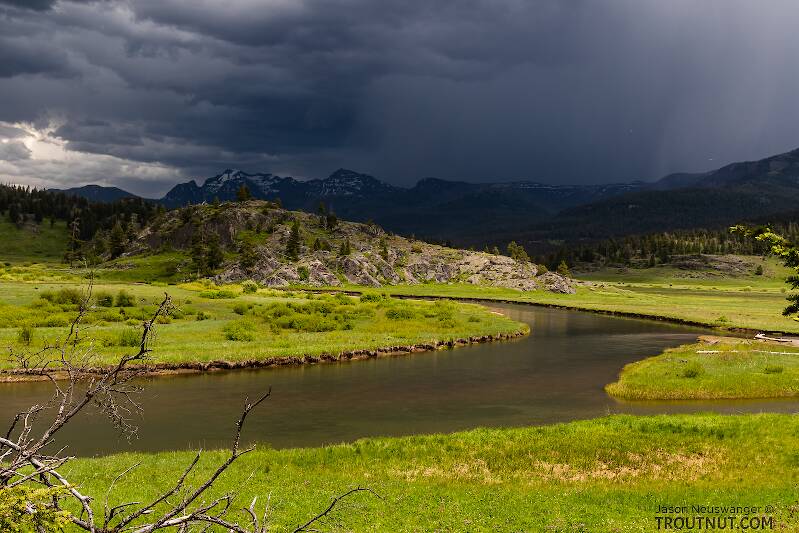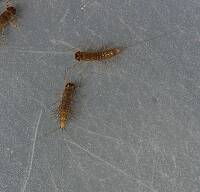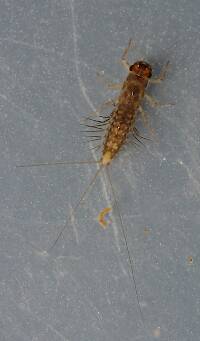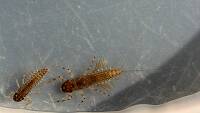
Salmonflies
Pteronarcys californica
The giant Salmonflies of the Western mountains are legendary for their proclivity to elicit consistent dry-fly action and ferocious strikes.
Featured on the forum

This one seems to tentatively key to Holocentropus, although I can't make out the anal spines in Couplet 7 of the Key to Genera of Polycentropodidae Larvae nor the dark bands in Couplet 4 of the Key to Genera of Polycentropodidae Larvae, making me wonder if I went wrong somewhere in keying it out. I don't see where that could have happened, though. It might also be that it's a very immature larva and doesn't possess all the identifying characteristics in the key yet. If Holocentropus is correct, then Holocentropus flavus and Holocentropus interruptus are the two likely possibilities based on range, but I was not able to find a description of their larvae.

Troutnut is a project started in 2003 by salmonid ecologist Jason "Troutnut" Neuswanger to help anglers and
fly tyers unabashedly embrace the entomological side of the sport. Learn more about Troutnut or
support the project for an enhanced experience here.
Falsifly on Apr 3, 2009April 3rd, 2009, 9:04 am EDT
I broke out the camera, set it on a tripod, assembled the vice, added a makeshift backdrop, and attempted to capture a few close-ups of my more productive midge imitations. They range in size from #20-#28, and these, very few patterns, have served me exceptionally well over the years.
This is the one that got me started many years ago. I was fishing the Western Slope of the Rockies about mid March and found myself surrounded by rising fish in a quiet back-water. I had no idea what was going on but was determined to figure it out. That day I visited the local fly shop and purchased a seine, veils, and Bug Balmer. The next day I was at the same spot and waited, hoping the event would reoccur, and it did. My seine was full of midge pupa and a few samples were collected. I always travel with my tying materials but I was void of what I thought I needed and so was the fly shop. Fortunately, not far away was a sewing store, so I decided to give it a try. Having never visited a sewing store before I was amazed at the materials, and I found what I was looking for. I purchased some DMC 6-strand cotton embroidery floss in color #611 and spent the night perfecting my rendition. Hook size and shape was an easy match with a TMC 2487 #20. A single strand of the floss over white thread gave the best color match when wet, and the head was finished off with heavy black thread leaving a short tag teased out for the legs. I was on the water at the same place the next day praying for a repeat, armed with this:

Well let me tell you, I was not only into fish I was into a lot of fish. As chance would have it another fisherman was slowly approaching, eyeing my success. He approached close enough that I broke the ice with a, “how are you doin”. Well that developed into a conversation that quickly led to his question, “what are you catchin em on”. By now I was under total control of my ego, I not only showed him what I was using but I gave him two of my flies. He thanked me saying he would give them a try and we separated just far enough to resume fishing. He was immediately into fish; as a matter of fact he was out fishing me. TRUE STORY!
A foot note for Gonzo:
I had purchased Midge Magic, read it once, and placed it back on the shelf prior to this trip, paying no more attention to the midge. Had I not remembered the mention of DMC floss and were to get it, this life changing event may never have occurred. If you speak with Mr. Holbrook or Koch thank them for me.
On this same trip I added a few looped strands of Antron and a single barb of pheasant tail, in an attempt to emulate the midge emerging from the puparium while awash in the film. And it caught fish!

The next year, early March, different river:
Now I was so hyped up on midge fishing that I refused to fish with any thing else. I had discovered the midge and the waters I was fishing were full of them. This time I was amidst something different; much smaller and all black, and the fish were gorging themselves on these gorgeous little things. It didn’t take me long to come up with this, and this pattern here has out fished all others combined. A #22 and a #26. Talk about easy to tie; their nothing but thread!!!


This last one holds a very special place in my heart. It was the last week of February on my first trip to the San Juan. I happened upon a very quite section of the river, in the upper flats, not too far down from the Dam. The fish were up taking very small dries that were new to me. And I didn’t even attempt to try; for I knew I had nothing even close, but I had my specimen. Short of the necessary hook size I was able to purchase a 25 pack of TMC 2488 in #28. The smallest size and only pack they had. Sometimes I think I carry good luck in my back pocket. I had never attempted to tie a #28 dry before and I made countless mistakes in an effort to get just one. This fly was so ugly, and it took me so long to get, just this one, that I quite trying, figuring I was only fooling myself. But I was determined to give it a try. I had a 12’ 5x leader in my vest that I tapered down to 8x and with this, and my one fly, I was at that spot the next day. Joining me as usual were the midges and the fish, right on schedule. Not a cloud in the sky, the temp was in the sixties and the water was almost like glass. The fish were rising sporadically, in both time and place, so I knew this wasn’t going to be easy. My one little #28 amongst Thousands of naturals left me with fleeting hope. I started at the tail of activity blindly casting at random rises with no clue were my fly was. I reined in my distance so that I could at least follow the greased leader to the fly but it was still difficult to pick out from the naturals. I settled on a range that gave me a general area to concentrate on, and figured that if a fish came up in that area I would just lift the rod tip taking up slack; which I knew, is all that is needed, to set the hook. Let the fish come up, take and turn, and then just lift the rod tip, it’s as easy as that. Remember this is 8x. I worked the area half way up unsuccessfully, when I finally spotted a fish rhythmically working a small area. I approached, ever so slowly, so as not to even ripple the water, and started to cast. I worked hard on that fish to the point were I could spot my fly, and he was taking naturals only inches from mine. But good luck was still in my back pocket; I saw him come up, take my fly and turn, and I gently lifted the rod tip and he was on. I landed that fish, a beautiful 22in Rainbow and one smaller one before I quite. Believe me when I say that the trip was not only complete, had I not caught another, but the whole year was complete.

I would like to leave you with a little poem by John Gay which can be found on page 93 of W. Patrick McCafferty’s Aquatic Entomology.
Around the steel no tortur’d worm shall twine,
No blood of living insect stain my line;
Let me, less cruel, cast feather’d hook,
With pliant rod athwart the pebbled brook,
Silent along the many margin stray,
And with fur-wrought fly delude the prey.
This is the one that got me started many years ago. I was fishing the Western Slope of the Rockies about mid March and found myself surrounded by rising fish in a quiet back-water. I had no idea what was going on but was determined to figure it out. That day I visited the local fly shop and purchased a seine, veils, and Bug Balmer. The next day I was at the same spot and waited, hoping the event would reoccur, and it did. My seine was full of midge pupa and a few samples were collected. I always travel with my tying materials but I was void of what I thought I needed and so was the fly shop. Fortunately, not far away was a sewing store, so I decided to give it a try. Having never visited a sewing store before I was amazed at the materials, and I found what I was looking for. I purchased some DMC 6-strand cotton embroidery floss in color #611 and spent the night perfecting my rendition. Hook size and shape was an easy match with a TMC 2487 #20. A single strand of the floss over white thread gave the best color match when wet, and the head was finished off with heavy black thread leaving a short tag teased out for the legs. I was on the water at the same place the next day praying for a repeat, armed with this:

Well let me tell you, I was not only into fish I was into a lot of fish. As chance would have it another fisherman was slowly approaching, eyeing my success. He approached close enough that I broke the ice with a, “how are you doin”. Well that developed into a conversation that quickly led to his question, “what are you catchin em on”. By now I was under total control of my ego, I not only showed him what I was using but I gave him two of my flies. He thanked me saying he would give them a try and we separated just far enough to resume fishing. He was immediately into fish; as a matter of fact he was out fishing me. TRUE STORY!
A foot note for Gonzo:
I had purchased Midge Magic, read it once, and placed it back on the shelf prior to this trip, paying no more attention to the midge. Had I not remembered the mention of DMC floss and were to get it, this life changing event may never have occurred. If you speak with Mr. Holbrook or Koch thank them for me.
On this same trip I added a few looped strands of Antron and a single barb of pheasant tail, in an attempt to emulate the midge emerging from the puparium while awash in the film. And it caught fish!

The next year, early March, different river:
Now I was so hyped up on midge fishing that I refused to fish with any thing else. I had discovered the midge and the waters I was fishing were full of them. This time I was amidst something different; much smaller and all black, and the fish were gorging themselves on these gorgeous little things. It didn’t take me long to come up with this, and this pattern here has out fished all others combined. A #22 and a #26. Talk about easy to tie; their nothing but thread!!!


This last one holds a very special place in my heart. It was the last week of February on my first trip to the San Juan. I happened upon a very quite section of the river, in the upper flats, not too far down from the Dam. The fish were up taking very small dries that were new to me. And I didn’t even attempt to try; for I knew I had nothing even close, but I had my specimen. Short of the necessary hook size I was able to purchase a 25 pack of TMC 2488 in #28. The smallest size and only pack they had. Sometimes I think I carry good luck in my back pocket. I had never attempted to tie a #28 dry before and I made countless mistakes in an effort to get just one. This fly was so ugly, and it took me so long to get, just this one, that I quite trying, figuring I was only fooling myself. But I was determined to give it a try. I had a 12’ 5x leader in my vest that I tapered down to 8x and with this, and my one fly, I was at that spot the next day. Joining me as usual were the midges and the fish, right on schedule. Not a cloud in the sky, the temp was in the sixties and the water was almost like glass. The fish were rising sporadically, in both time and place, so I knew this wasn’t going to be easy. My one little #28 amongst Thousands of naturals left me with fleeting hope. I started at the tail of activity blindly casting at random rises with no clue were my fly was. I reined in my distance so that I could at least follow the greased leader to the fly but it was still difficult to pick out from the naturals. I settled on a range that gave me a general area to concentrate on, and figured that if a fish came up in that area I would just lift the rod tip taking up slack; which I knew, is all that is needed, to set the hook. Let the fish come up, take and turn, and then just lift the rod tip, it’s as easy as that. Remember this is 8x. I worked the area half way up unsuccessfully, when I finally spotted a fish rhythmically working a small area. I approached, ever so slowly, so as not to even ripple the water, and started to cast. I worked hard on that fish to the point were I could spot my fly, and he was taking naturals only inches from mine. But good luck was still in my back pocket; I saw him come up, take my fly and turn, and I gently lifted the rod tip and he was on. I landed that fish, a beautiful 22in Rainbow and one smaller one before I quite. Believe me when I say that the trip was not only complete, had I not caught another, but the whole year was complete.

I would like to leave you with a little poem by John Gay which can be found on page 93 of W. Patrick McCafferty’s Aquatic Entomology.
Around the steel no tortur’d worm shall twine,
No blood of living insect stain my line;
Let me, less cruel, cast feather’d hook,
With pliant rod athwart the pebbled brook,
Silent along the many margin stray,
And with fur-wrought fly delude the prey.
Falsifly
When asked what I just caught that monster on I showed him. He put on his magnifiers and said, "I can't believe they can see that."
When asked what I just caught that monster on I showed him. He put on his magnifiers and said, "I can't believe they can see that."
Martinlf on Apr 3, 2009April 3rd, 2009, 3:44 pm EDT
Falsifly,
I loved the stories, and the chance to share your success vicariously. You really have me thinking midge. Although, as Jack says, "Compared to the Hairy Honeybug all other flies are just hookers," I'm going to add the teensy weensies to my active arsenal for the season.
I loved the stories, and the chance to share your success vicariously. You really have me thinking midge. Although, as Jack says, "Compared to the Hairy Honeybug all other flies are just hookers," I'm going to add the teensy weensies to my active arsenal for the season.
"He spread them a yard and a half. 'And every one that got away is this big.'"
--Fred Chappell
--Fred Chappell
GONZO on Apr 4, 2009April 4th, 2009, 3:36 am EDT
If you speak with Mr Holbrook or Koch thank them for me.
Falsifly, I talked to Don at the annual FFCH gathering yesterday. Unfortunately, I did not see your post until today. I'm sure that he would have been very pleased to learn that he played a role in inspiring another midge maven. Ed was not there. Sadly, he has reached the point where memories of recent times are largely lost to him, and he probably would not recognize me.
Shawnny3 on Apr 5, 2009April 5th, 2009, 9:12 pm EDT
Very nice flies, Falsifly, and thank you for sharing your delightful experiences with them. I've fished midges with a little success in the dead of winter, but it's been awhile since I've fished them. I guess I never really felt like I knew what I was doing,so fishing other things and ways took precedence. But your stories make me want to try them again, this time in earnest. As if I need another flyfishing obsession...
-Shawn
-Shawn
Jewelry-Quality Artistic Salmon Flies, by Shawn Davis
www.davisflydesigns.com
www.davisflydesigns.com
Lastchance on Apr 6, 2009April 6th, 2009, 12:32 pm EDT
falsify: great stories and flies. do you use a base of white thread for all of your midges? also, do you use just one strand of the six strand DMC floss for each fly? i ran into some fish rising to midges and was totally unprepared. i had some, but not much of a variety.
Falsifly on Apr 6, 2009April 6th, 2009, 2:45 pm EDT
Lastchance,
No. I found that the floss color I used on the first fly pictured was a very good match when it was dry but when wet it darkened up. I was able to counteract the darkening by applying over a base of white.
Yes. In the sizes I tie using more than one strand results in too much bulk. If you separate the six strands you will find that they each contain two strands, but I have found that the individual strands are unstable and tend to pull apart too easily. The last fly pictured, the dry, was dubbed.
do you use a base of white thread for all of your midges?
No. I found that the floss color I used on the first fly pictured was a very good match when it was dry but when wet it darkened up. I was able to counteract the darkening by applying over a base of white.
do you use just one strand of the six strand DMC floss for each fly?
Yes. In the sizes I tie using more than one strand results in too much bulk. If you separate the six strands you will find that they each contain two strands, but I have found that the individual strands are unstable and tend to pull apart too easily. The last fly pictured, the dry, was dubbed.
Falsifly
When asked what I just caught that monster on I showed him. He put on his magnifiers and said, "I can't believe they can see that."
When asked what I just caught that monster on I showed him. He put on his magnifiers and said, "I can't believe they can see that."
Quick Reply
Related Discussions
Topic
Replies
Last Reply
5
Jun 22, 2012
by Falsifly
by Falsifly








